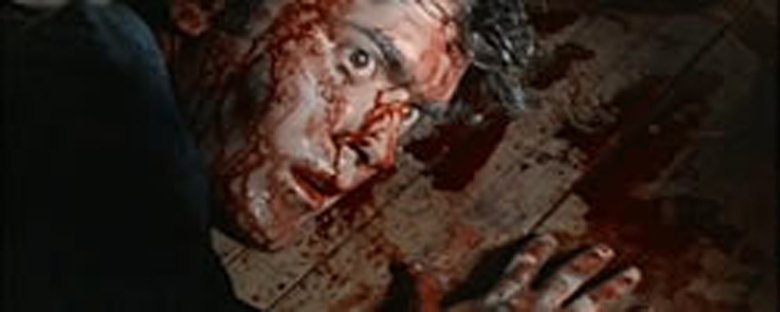Reviews
The Ultimate Experience in Grueling Horror
Sam Raimi
USA, 1981
Credits
Review by Rumsey Taylor
Posted on 03 October 2005
Source Anchor Bay Entertainment DVD
Related articles
Features: 31 Days of Horror
Reviews: Evil Dead II
Of the mediums in which horror is commodified, film is disputably the least horrific. The films that populate the genre – and seldom the ones that characterize it – may elicit laughter; others may be strewn with incompetence, plot contrivances, and generous suspensions of disbelief. Their flaw is that fear and shock are more subjective, difficultly reprised emotional responses than, say, laughter and tears. Most often, horror films generate suspense with the unknown, and climax with revelation, making them disposable entertainments uncharacterized by longevity.
The Evil Dead is in this regard an anomaly. It is, however, crudely made, constructed with makeshift cinematography (enabled by Vaseline and 2x4s), and places little emphasis on characterization—by these virtues, disposable. (This is not to mention the attempts toward sentimentality that fail completely.) The first third of the film is unremarkable: we find five teens (two men, three women) en route to an overnight stay in a rural cabin. They discover the location is the former place of study for some sort of professor; their responses to a recording that recites passages from the ominously titled Necronomicon Ex Mortis are so dumbly curious the film loses any grounding the premise has in being manifested realistically. In its opening minutes, The Evil Dead has no distinctions and no suspense—the features of an exercise designed expressly to capitalize on horror’s profit, as demonstrated in John Carpenter’s Halloween. These minutes, however, do not presage the incessant invention and horror that is to come. This occurs in the first twenty minutes, allowing the film’s remainder to absorb what mayhem the feeble premise warrants, which would be a lot.
With little patience (a word that describes no aspect of this film) the troupe retires for the evening, and one of the girls, Cheryl, is chased and captured by a throng of vines and branches. She is pinned down, her clothes torn, and her legs spread apart in preparation for rape. This sequence — the most graphic in the film — demonstrates a scenario that requires no liberties in order to instill fright, but what’s most significant in this case is the rapist’s lack of identity or form. There is no face on which to displace rage, on which to identify evil. This is the first crime of a tactical force capable of assuming limitless nefarious roles: here, a rapist, and later a liar, a disease, a killer, a plague—its many iterations are incessant and replenishing. Cheryl is left alive to warn her party of a threat that escapes the most logical descriptions.
From this point forward, The Evil Dead evolves, and this is the most dynamic quality of the film. It begins awkwardly and with little plausibility, and becomes a heedlessly ambitious, playful, and inventive exercise—it’s duct tape filmmaking. It combines amateur actors with an Oldsmobile and an unadventurous Tennesseean locale, but once the blood of one in the subjected party is hosed onto the clothes and faces of the remainder, an urgent, tangible fright becomes manifested. Likewise, with a flurry of dismembered body parts, the film spells its intentions in scaring with complete, relentless excess.
The film doesn’t suit categorization because it’s flaws and strengths are so widely dispersed. Simply put, it contains no singularly distinctive element, yet it is well endeared; it’s flawed yet frightening, a horror film at its pure essence. This thought is validated by its sequel—the unqualified masterpiece of the trilogy, but not without some fundamental debt to its prequel.
We don’t do comments anymore, but you may contact us here or find us on Twitter or Facebook.



